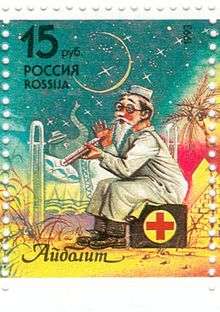Doctor Aybolit

Doctor Aybolit (Russian: Доктор Айболит, Aibolit) is a fictional character from the children's poems Aybolit and Barmaley by Korney Chukovsky. The name may be translated as "Ouch, [it] hurts!"
The origins of Aybolit can be traced to Doctor Dolittle by Hugh Lofting. Like Buratino by Aleksey Tolstoy or The Wizard of the Emerald City by Alexander Volkov, Aybolit is a loose adaptation of a foreign book by a Russian author. For example, the adaptation includes a Pushmi-pullyu, тяни-толкай (tyani-tolkay) in Russian. The prose adaptation always credited Lofting in the subtitle, while the Aybolit poems are original works.
The character became a recognizable feature of Russian culture. The poems found their following in the films Doktor Aybolit (black and white, 1938), Aybolit 66 (Mosfilm, 1967, English title: Oh How It Hurts 66), and Doctor Aybolit (animated film, Kyivnaukfilm, 1985). The doctor's appearance and name are used in brand names, logos, and slogans of various medical establishments, candies, etc.

Aybolit's antagonist, the evil pirate Barmaley, became an archetypal villain in Russian culture. Barmaley debuted in Chukovsky's book Crocodile in 1916, 13 years before the first appearance of Aybolit.
The poems Aybolit and Barmaley generated a number of Russian catchphrases such as "Nu spasibo tebe, Aybolit!" (Thanks to you, Aybolit), "Ne hodite deti v Afriku gulyat" (Children, don't go to Africa for a stroll). They were also the inspiration for the Barmaley Fountain in Stalingrad.
A loose English adaptation in verse was published by Richard N. Coe in 1967, entitled Doctor Concocter.[1] It starts "Doctor Concocter sits under a tree, He's ever so clever, he has a degree!"[2]
A living prototype of the character was Chukovsky's acquaintance, Vilnian Jewish doctor Zemach Shabad (1864–1935),[3] to whom a monument was dedicated in Vilnius on 16 May 2007.
References
- ↑ A review of Doctor Concocter, The Spectator, 1967, v. 219, p. 540
- ↑ Chukovskiĭ 1967
- ↑ "Zemach Shabad, a Jewish Doctor Aybolit" (Russian)
Bibliography
- Chukovsky, Kornei (1965), Doktor Aibolit, Harrap, p. 79, ISBN 978-0-245-58209-7
- Chukovskiĭ, Korneĭ (1967), Richard N. Coe, ed., Doctor Concocter, translated by Richard N. Coe, Oxford University Press, p. 24, ISBN 978-0-19-279633-2
- Chukovsky, Kornei (1980), Doctor Powderpill, translated by D. Rottenberg, Central Books Ltd., ISBN 978-0-7147-1468-4
- Chukovskii, Kornei (1980), Doktor Aibolit (in Russian), Znanie Bookstore, ISBN 978-5-88105-113-6
- Chukovsky, Kornei (2004), Doctor Ouch, translated and illustrated by Jan Seabaugh, Smith Publishing, p. 43, ISBN 978-0-9740551-0-7
- Chukovskii, Kornei (2004), Ajbolit (in Russian), Samovar, ISBN 5-85066-263-4
- Čukovskij, Kornej (1999), Stichi i skazki: Ot dvuch do pjati (in Russian), Planeta detstva, p. 701, ISBN 978-5-236-00167-0. Extracts of Aybolit and Barmaley.